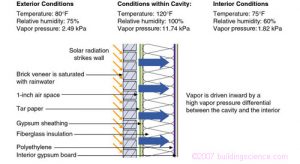Building Science for Dummies


When it comes to building a custom home, the fun part is choosing the building site, designing the home, and selecting colors. What most home buyers don’t think about is how the construction of their home will impact their comfort and affect their health. That’s where building science comes in. A house is much more than four walls and a roof. It is an interactive system made up of many parts (e.g. the structure itself, ventilation systems, heating, and cooling systems, etc.). Each component influences the performance of the entire system.
Home building materials and home building techniques have improved substantially over the years. While this is good overall, for builders and home buyers that haven’t kept up, it can be bad. When homes were leaky, moisture that was created in the home could escape. That doesn’t happen in today’s homes. Let’s learn more about how building science impacts your home.
Your Home is a Collection of Systems
Your home is a collection of systems that work together (usually) to support your comfort, protect you from the elements, and to promote your health. It’s called building science, not building art. Buildings perform in a very predictable fashion. The process is governed by the second law of thermodynamics:
The second law of thermodynamics says that when energy changes from one form to another form, or matter moves freely, entropy (disorder) in a closed system increases. Differences in temperature, pressure, and density tend to even out horizontally after a while.
The performance characteristics of a home are based on four basic principles of physics. While solid design is the starting point for a healthy home it is important to remember that proper maintenance is required to keep all systems working properly.
Here are three basic concepts to remember as you review the four principles:
- Moisture moves from wet to dry.
- Heat moves from hot to cold.
- Air moves from high pressure to low pressure.
The Four Principles

Source: Building Science Corp
Moisture Movement – The moisture level in a home depends on a number of different factors such as lifestyle (showering and cooking), the number of occupants, leaks, and air or ground moisture. Moisture always wants to move from areas of high vapor pressure to areas of low vapor pressure. Vapor pressure is the pressure exerted by water molecules in a mixture of air. For example: when a home is being heated, moisture wants to move to the outside, and when the home is being air conditioned, moisture wants to move from the outside to the inside of your home.
One of the most common terms we use to discuss moisture in homes is known as relative humidity (RH). RH is a percentage that indicates the amount of moisture in the air relative to the maximum amount the air can hold at that temperature. Warm air can hold more moisture than cool air, so the RH of a sample of air will change as the temperature changes, even though the actual amount of moisture in the sample does not. If we raise the temperatures, we lower the RH and if we lower the temperature, we raise the RH.
Dew point Temperatures – Check any weather station or go to Weather.com and you will see this thing called the dew point. Do you ever wonder why they bother to tell you what it is? The dew point is the temperature below which water droplets begin to condense and dew can form. This is a function of both temperatures and the amount of moisture in the air. If we have a Dew point of 40 degrees, any surface in the home that reaches this temperature will have liquid water on it. To prevent this condensation, we can either raise the surface temperature or lower the relative humidity.
How does dew point impact your home? Assume a dew point temperature of 40 degrees and start with an interior temperature of 70 degrees and 40% relative humidity, your home would not see any condensation on surfaces. If we start to lower the temperature, our RH goes up, and at about 62 degrees we would start to see condensation. In most homes, the obvious place to visually see this is on windows. If we raise the temperature or lower the relative humidity to get the window surfaces above the dew point, we would eliminate the window condensation.
RELATED: Hydrostatic Pressure – What you need to know
Pressures – Remember concept #3, air moves from high pressure to areas of low pressure. Pressure and holes are two of the biggest concerns in residential construction. These two areas are what most people really understand when it comes to building an energy efficient home. Pressures can be caused by outside conditions such as wind and temperature or inside conditions created with exhaust fans (both in the bathroom and kitchen), air handlers, chimneys and vents, and clothes dryers.
In order for pressures to influence how a house performs, there needs to be a hole. It can be an intentional hole (i.e. a bathroom vent) or an unintentional hole (i.e. a gap around a window). When you feel cold air entering your house, it’s the result of both a hole and pressure. If you take either one of these away, the air cannot move. An important point to remember is that cold air entering your home may be replacing warm air leaving your home. We tend not to notice air leaking out of our home as much as air leaking into our homes, although they can be equal amounts (think about when you felt cold air coming in around your outlets on a cold, windy winter day). Air leaking out can generate problems with attic and wall condensation in cold climates and ice dams in climates with heavier snow loads.
Heat Flow – Heat moves from areas of higher temperature to areas of lower temperature. When heating, your home’s warm air is escaping to the outside, and while cooling the opposite is happening. Insulation is designed to resist heat flow, so the higher the R-value (R-value is the resistance to heat flow: the higher the number, the better an insulation material is able to slow heat flow), the slower heat will move into or out of a home.
Even with insulation, if we have a hole and pressure, we can move a tremendous amount of heat through insulation (convection). These same holes and pressures can also move a substantial amount of moisture through the insulation. Remember dew points? If we try to move moist air through insulation, the dew point and the resulting condensation can occur in closed wall or ceiling systems. This is bad! With window condensation, it is easy to see the moisture. When condensation happens walls and attics it isn’t as obvious. Most of the time it is seen when stains appear. Persistent moisture in these areas can result in mold and rot.
MODULAR CONSTRUCTION PROVIDES THE VEHICLE TO DELIVER ON BUILDING SCIENCE
Building science views the home as a system. Modular construction is a building system itself. It is a method of building indoors that assembles these subsystems in a controlled environment. A home is broken down into subsystems or components. These components are then assembled into a larger component called a module. Because a modular home is built indoors, subsystems can be thoughtfully designed and skillfully assembled.
Just like the study of building science continues to improve every year, so does modular construction. Factories are able to do more and more in the factory thereby reducing defects and improving the overall livability of the home. A system only performs when it is installed correctly. Modular offers the construction method to deliver on building science.
The post Building Science for Dummies appeared first on Impresa Modular.




